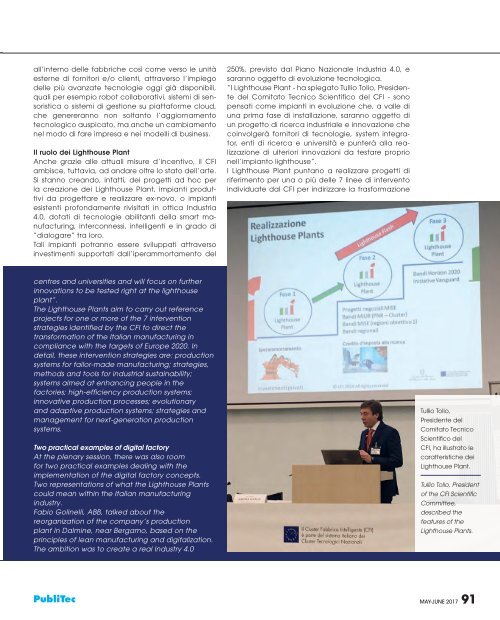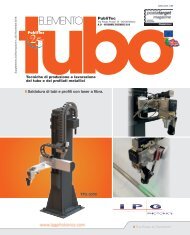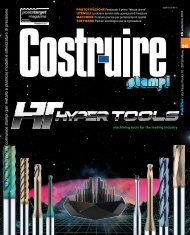AsseMec120_MAGGIU_2017
You also want an ePaper? Increase the reach of your titles
YUMPU automatically turns print PDFs into web optimized ePapers that Google loves.
all’interno delle fabbriche così come verso le unità<br />
esterne di fornitori e/o clienti, attraverso l’impiego<br />
delle più avanzate tecnologie oggi già disponibili,<br />
quali per esempio robot collaborativi, sistemi di sensoristica<br />
o sistemi di gestione su piattaforme cloud,<br />
che genereranno non soltanto l’aggiornamento<br />
tecnologico auspicato, ma anche un cambiamento<br />
nel modo di fare impresa e nei modelli di business.<br />
Il ruolo dei Lighthouse Plant<br />
Anche grazie alle attuali misure d’incentivo, il CFI<br />
ambisce, tuttavia, ad andare oltre lo stato dell’arte.<br />
Si stanno creando, infatti, dei progetti ad hoc per<br />
la creazione dei Lighthouse Plant, impianti produttivi<br />
da progettare e realizzare ex-novo, o impianti<br />
esistenti profondamente rivisitati in ottica Industria<br />
4.0, dotati di tecnologie abilitanti della smart manufacturing,<br />
interconnessi, intelligenti e in grado di<br />
“dialogare” tra loro.<br />
Tali impianti potranno essere sviluppati attraverso<br />
investimenti supportati dall’iperammortamento del<br />
250%, previsto dal Piano Nazionale Industria 4.0, e<br />
saranno oggetto di evoluzione tecnologica.<br />
“I Lighthouse Plant - ha spiegato Tullio Tolio, Presidente<br />
del Comitato Tecnico Scientifico del CFI - sono<br />
pensati come impianti in evoluzione che, a valle di<br />
una prima fase di installazione, saranno oggetto di<br />
un progetto di ricerca industriale e innovazione che<br />
coinvolgerà fornitori di tecnologie, system integrator,<br />
enti di ricerca e università e punterà alla realizzazione<br />
di ulteriori innovazioni da testare proprio<br />
nell’impianto lighthouse”.<br />
I Lighthouse Plant puntano a realizzare progetti di<br />
riferimento per una o più delle 7 linee di intervento<br />
individuate dal CFI per indirizzare la trasformazione<br />
centres and universities and will focus on further<br />
innovations to be tested right at the lighthouse<br />
plant”.<br />
The Lighthouse Plants aim to carry out reference<br />
projects for one or more of the 7 intervention<br />
strategies identified by the CFI to direct the<br />
transformation of the Italian manufacturing in<br />
compliance with the targets of Europe 2020. In<br />
detail, these intervention strategies are: production<br />
systems for tailor-made manufacturing; strategies,<br />
methods and tools for industrial sustainability;<br />
systems aimed at enhancing people in the<br />
factories; high-efficiency production systems;<br />
innovative production processes; evolutionary<br />
and adaptive production systems; strategies and<br />
management for next-generation production<br />
systems.<br />
Two practical examples of digital factory<br />
At the plenary session, there was also room<br />
for two practical examples dealing with the<br />
implementation of the digital factory concepts.<br />
Two representations of what the Lighthouse Plants<br />
could mean within the Italian manufacturing<br />
industry.<br />
Fabio Golinelli, ABB, talked about the<br />
reorganization of the company’s production<br />
plant in Dalmine, near Bergamo, based on the<br />
principles of lean manufacturing and digitalization.<br />
The ambition was to create a real Industry 4.0<br />
Tullio Tolio,<br />
Presidente del<br />
Comitato Tecnico<br />
Scientifico del<br />
CFI, ha illustrato le<br />
caratteristiche dei<br />
Lighthouse Plant.<br />
Tullio Tolio, President<br />
of the CFI Scientific<br />
Committee,<br />
described the<br />
features of the<br />
Lighthouse Plants.<br />
PubliTec<br />
MAY-JUNE <strong>2017</strong> 91





